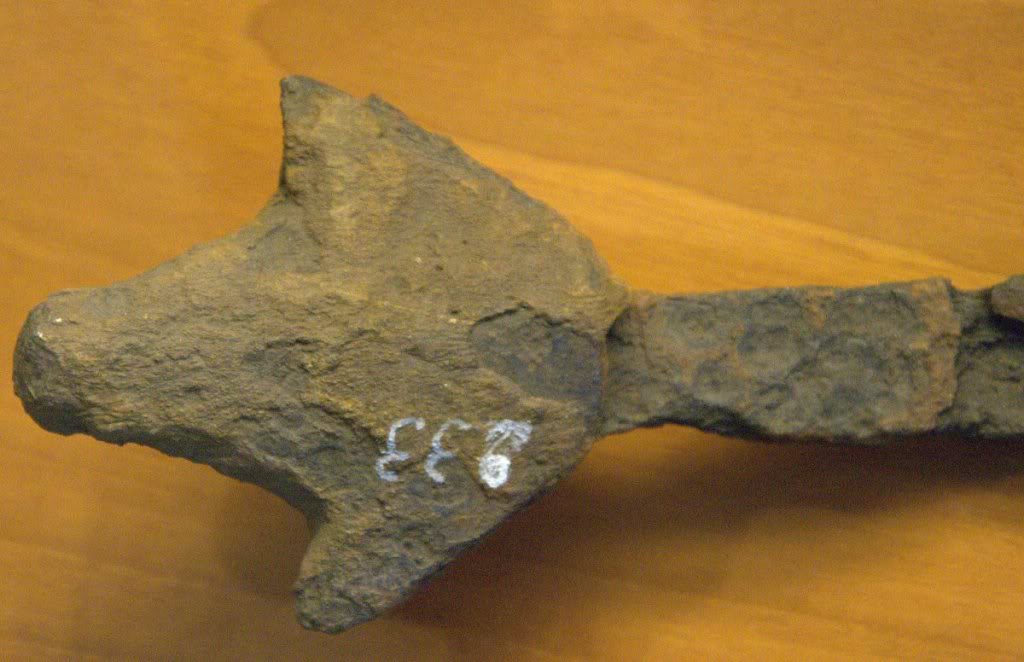An interesting and not well known falchion with a beautiful type L pommel. Blade apparently is very thin and has no distal taper (or was the edge on the concave side?).
Pics couldn't load from my ipad, they will be available tonight. Hi res images at request by pm.
| Bruno Giordan wrote: |
| An interesting and not well known falchion with a beautiful type L pommel. Blade apparently is very thin and has no distal taper (or was the edge on the concave side?). |
This is an interesting piece, Oakeshott dates pommel L to 12th 13th century (The Sword in the Age of Chivalry) if this is true it would make it a very old falchion.
I note on an other form that you may contact Sforzesco castle to find out more information, if you do I would love to hear more about the piece such as how it came into the collection, and blade measurements and such.
Thanks for sharing
mackenzie
My knowledge is nothing compared to late Mr. Oakeshott's, but I really don't think pommels like these are earlier than 14th century. For me it's just a subjective feel without any real evidence, but I don't sense the spirit of 12th or 13th century when looking at that pommel and a complete weapon.
| Mackenzie Cosens wrote: | ||
This is an interesting piece, Oakeshott dates pommel L to 12th 13th century (The Sword in the Age of Chivalry) if this is true it would make it a very old falchion. I note on an other form that you may contact Sforzesco castle to find out more information, if you do I would love to hear more about the piece such as how it came into the collection, and blade measurements and such. Thanks for sharing mackenzie |
What puzzles me is the apparent lack of distal taper. The blade is covered by a random layer of what appears to be soot mingled with rust, in its cleaner spots the thickness appear to my eye to be no more than 2.5 mm. In some places there is what could be wood from the scabbard embedded into the surface. Not to mention the fact that the cross is off axis by let's say one degree, which could be intentional as the tang is apparently following the slight axial curvature of the blade.
| Bruno Giordan wrote: | ||
What puzzles me is the apparent lack of distal taper. The blade is covered by a random layer of what appears to be soot mingled with rust, in its cleaner spots the thickness appear to my eye to be no more than 2.5 mm. In some places there is what could be wood from the scabbard embedded into the surface. Not to mention the fact that the cross is off axis by let's say one degree, which could be intentional as the tang is apparently following the slight axial curvature of the blade. |
No distal taper and thin metal my due to corrosion or cleaning or it may be what this type of falchion is like.
It appears that the tang is bent, possibly under a heavy weight and depending on the condition of the metal it may not take that much force to distort it. If it is distorted that may account for the cross being off true. I know that some field finds end up distorted by tractors and such or just being in the ground.
Have you found anything about how it came into the collection? That may tell you something how close it may be to original and if it is distorted.
it is very cool that James Elmslie has an other piece for his Falchion work.
It does make you wonder what else is sitting museums hidden under a label we don't recognize.
mackenzie
| Mackenzie Cosens wrote: |
| it is very cool that James Elmslie has an other piece for his Falchion work. |
Sorry mate I must have read the thread sideways because I can't figure out what you are refering to?
The falchion is superb. I'm delighted to see this example, as med. falchions are rare indeed. I have kept a moat vassal blade for amost a year now, but can't be satisfied with any hilt design so far. The thorpe has been seen too often, the conveyers as well. There is one in Brussel also, porte de Hal. The most fancy I've seen is in cluny, and the reversed blade from the musee de l'armee. Save those Mike loades unveiled a recent example of a castillon hilted one kept at the Royal Armoury in his book swords and swordsmen. Beside these, no luck.
Corrosion did it's work though, and figuring out the exact shape of the pommel is a bit tricky, even if the shots you took are really good.


Thanks again for these Bruno.
J
| Julien M wrote: | ||
... J |
Sorry my bad for reference posts from an other form. Mr. Elmslie, has been gathering information on medieval European falchion.
m
I think it's ironic that, if I saw a modern maker or manufacturer producing falchions like this one, I probably would have condemned the modern reproductions as ahistorical nonsense. Goes to show that you can never be too presumptuous in how much you know.
Page 1 of 1
You cannot post new topics in this forumYou cannot reply to topics in this forum
You cannot edit your posts in this forum
You cannot delete your posts in this forum
You cannot vote in polls in this forum
You cannot attach files in this forum
You can download files in this forum
All contents © Copyright 2003-2006 myArmoury.com — All rights reserved
Discussion forums powered by phpBB © The phpBB Group
Switch to the Full-featured Version of the forum
Discussion forums powered by phpBB © The phpBB Group
Switch to the Full-featured Version of the forum